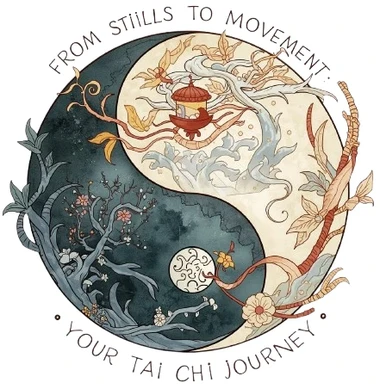“Sink the shoulders, drop the elbows.”
Your teacher says it again. You nod. You try. But inside, you’re thinking: “My shoulders are already down!”
Here’s the truth: You might not be sinking them at all.
This phrase—沉肩坠肘 (Chen Jian Zhui Zhou)—is one of the most repeated instructions in Tai Chi. It’s also one of the most misunderstood, and truly learning how to relax your shoulders in Tai Chi is a game-changer.
Most people think it means pushing the shoulders down. Or clamping the elbows to the ribs. But that’s not it. Not even close.
In fact, doing it wrong creates more tension. More stiffness. More confusion.
I’ve been there. I’ve felt the frustration. And I’ve seen how unlocking this one principle transforms everything—from posture to power to peace.
Let’s break it down. Let’s make it real.
Let’s learn how to relax the right way.
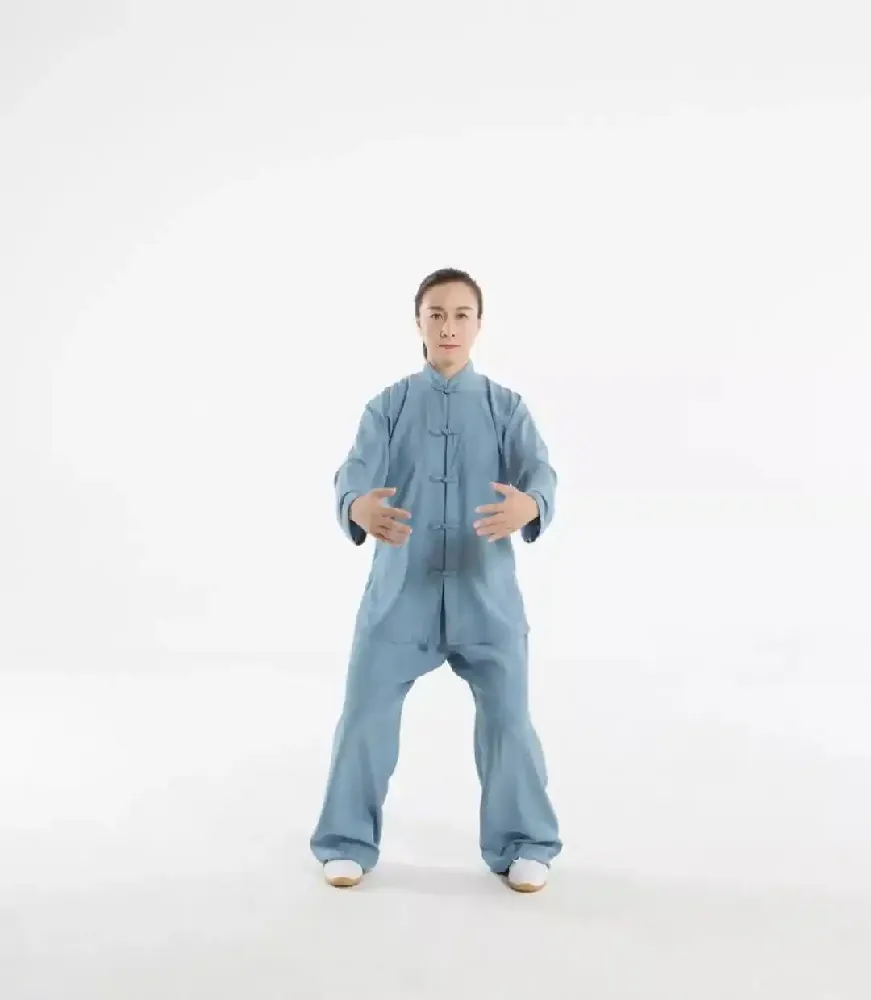
Why It Matters: More Than Just Relaxation
“Sinking the shoulders and dropping the elbows” isn’t just about looking good. It’s about function. It’s about flow. It’s about unlocking the full potential of Tai Chi.
Here’s why this matters so much:
It Connects the Power Path
Your shoulders and elbows are bridges. They link your torso to your hands. If they’re tense or lifted, the bridge breaks.
- Raised shoulders = power stuck in the chest
- Lifted elbows = energy leaks before reaching the hands
Only when the shoulders sink and the elbows drop can force travel from the feet to the fingers.
This is how “Jin” (internal power) flows. This is how Tai Chi becomes whole.
Exclusive Tip: During practice, imagine your elbows hanging from your shoulders like weights. Let gravity do the work. The Art of Song: How to Relax Your Muscles (Without Going Limp) in Tai Chi.
It Protects Your Joints
Tense shoulders aren’t just inefficient. They’re risky.
When your shoulders lift, your scapula shifts. Your rotator cuff strains. Your neck tightens.
Over time, this leads to pain. Fatigue. Even injury.
But when you sink the shoulders, the scapula settles. The joint aligns. The muscles relax.
It’s not just safer. It’s smarter.
Exclusive Tip: After each form, do a shoulder check. If you feel tightness, pause. Breathe. Reset.
It Helps Qi Sink
In Tai Chi, we talk about “Qi sinking to the Dantian.” That’s your energy center—just below the navel.
But if your shoulders are tense, Qi floats. It gets stuck in the chest. You feel anxious. Unstable. Disconnected.
Sink the shoulders, and Qi follows. Drop the elbows, and breath deepens. Suddenly, you feel grounded. Centered. Calm.
Exclusive Tip: Pair shoulder sinking with long exhales. Let the breath guide the body.
It Creates Peng Energy
Peng is one of Tai Chi’s core energies. It’s expansive. Elastic. Supportive.
But you can’t feel Peng with stiff shoulders or locked elbows.
Peng needs roundness. It needs space. It needs relaxation.
When the shoulders sink and the elbows drop, the arms form a natural arc. Like a balloon filled with air. Soft, but full. That’s Peng.
Exclusive Tip: Practice “Holding the Ball” posture. Feel the roundness. Let the elbows float below the wrists.
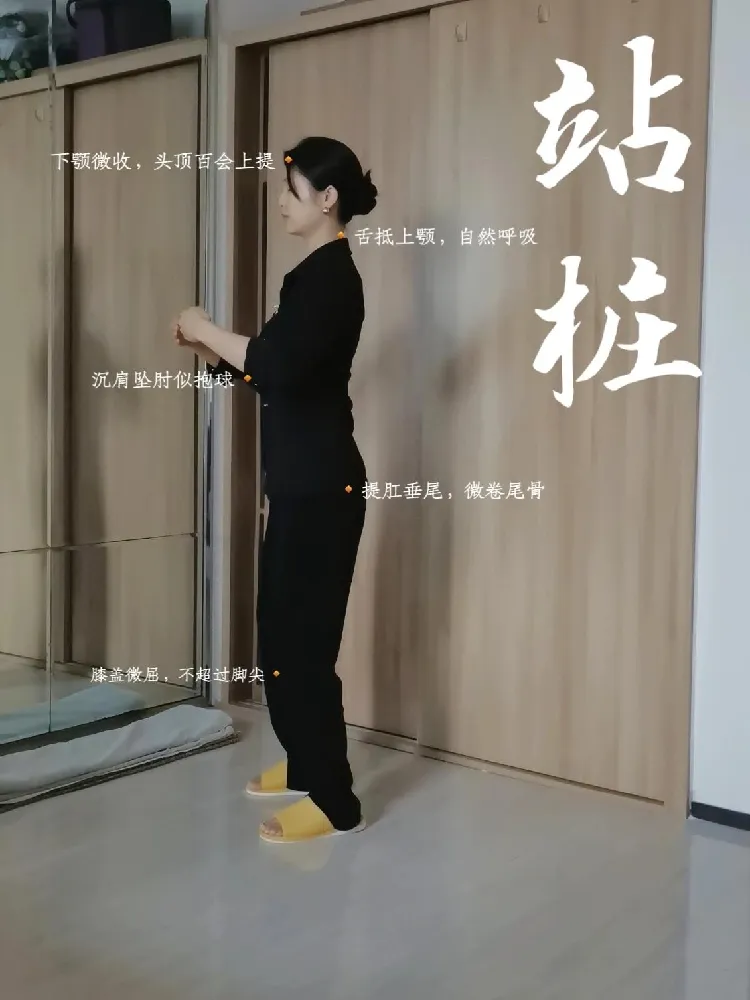
What It’s Not: Common Misunderstandings
Let’s clear up the confusion around what 'sink shoulders drop elbows' really means, because most people get this wrong.
Here are two big mistakes:
Mistake 1: Forcing the Shoulders Down
You push. You strain. You try to “sink” by using effort.
But that just activates the trapezius. It creates tension. It blocks flow.
True sinking is passive. It’s a release. Not a push.
What to do instead: Imagine your shoulders deflating like balloons. Let them settle. Don’t force them.
Mistake 2: Clamping the Elbows In
You tuck the elbows tight. You squeeze them to your ribs. You think this is “dropping.”
But it kills the arc. It blocks Peng. It stiffens the movement.
What to do instead: Let the elbows hang. Keep space under the armpits. Feel the arms round—not rigid.
Exclusive Tip: Use a small ball or folded towel under each armpit during practice. It teaches space and softness. Opening the Kua: The Secret to Tai Chi's Power and Rootedness.
How to Actually Do It: A Three-Step Method
You’ve heard the advice. You’ve felt the confusion. Now let’s make it practical.
Here’s a simple, three-step method to truly sink the shoulders and drop the elbows in Tai Chi.
No force. No guesswork. Just awareness, alignment, and gravity.
Step 1: Use Your Mind First
Relaxation starts in the mind. Before the body can release, the brain has to let go.
Try these visualizations:
- For shoulders: Imagine the top of your shoulder (Jianjing point) slowly deflating like a balloon.
- For elbows: Picture a small weight hanging from each elbow, gently pulling it toward the earth.
Don’t push. Don’t strain. Just imagine.
Exclusive Tip: During standing meditation, silently repeat: “Let go. Let drop.” It’s a cue that works wonders.
Step 2: Check Your Structure
Relaxation isn’t just softness. It’s alignment.
Here’s what to look for:
- Shoulders: Your collarbones should be level—not tilted or lifted. Your scapula should wrap slightly forward and down.
- Elbows: They should always be lower than the wrists. Keep a soft bend—never locked, never collapsed.
This creates space. It supports flow. It allows Peng energy to form.
Exclusive Tip: Use a mirror. Or better—film yourself. Watch for shoulder lift and elbow tension. Awareness is the first fix.
Step 3: Let the Whole Body Help
Here’s the secret: You can’t relax the shoulders in isolation. You need the whole body to support it.
When your crown lifts (虚灵顶劲, a principle we explore in our guide to proper Tai Chi posture) and your tailbone sinks, the spine elongates. This creates a gentle pull—up and down. The shoulders naturally hang. The elbows naturally drop.
It’s not a local adjustment. It’s a global release.
Exclusive Tip: Practice “Wuji Standing” with focus on crown and tailbone. Let the spine stretch. Let the shoulders follow.
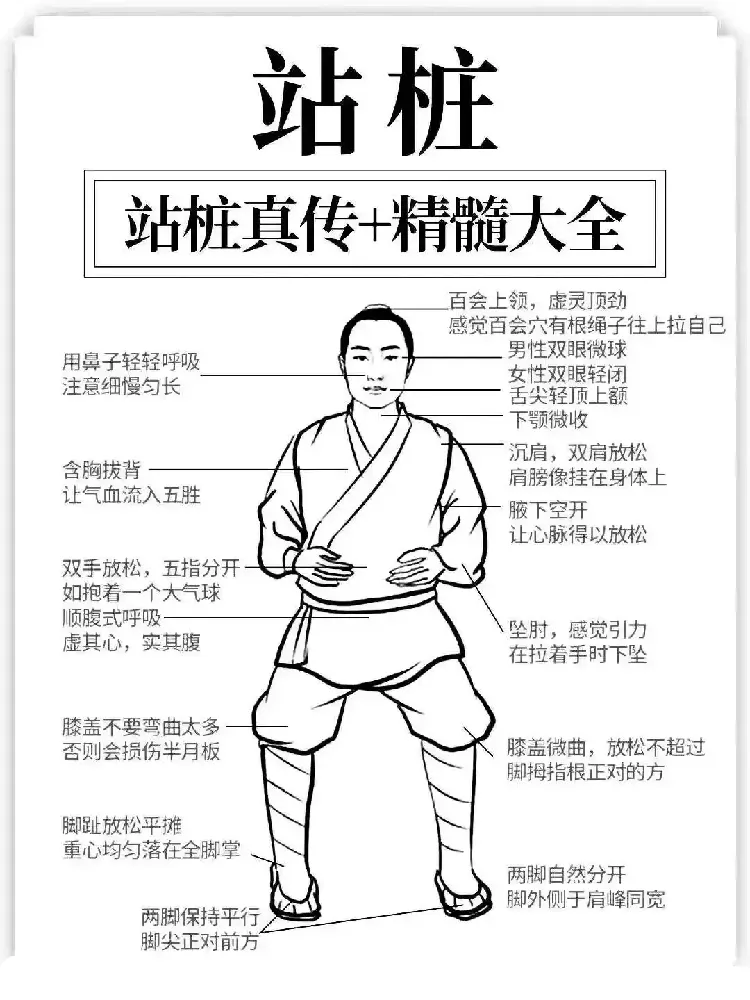
Standing Stake
- Standing StakeThe True Transmission + Essence of Standing Stake
- Baihui (the top of the head) is lifted upward, with a sense of emptiness and agility in the top of the head: Feel like there's a rope pulling you upward at Baihui acupoint.
- Men keep eyes slightly open; women close eyes lightly.
- The tip of the tongue lightly touches the upper palate.
- The lower jaw is slightly retracted.
- Breathe gently through the nose, paying attention to being slow, even and long.
- Sink the shoulders, relax both shoulders: Shoulders feel like hanging on the body.
- Keep the armpits open: Let the heart meridians relax.
- Relax the hands, spread the five fingers: As if holding a big balloon.
- Abduct the elbows, feel the gravity pulling the hands downward.
- Do abdominal breathing: Empty the heart, fill the abdomen.
- Don't bend the knees too much: Otherwise, it will damage the meniscus.
- Knees are slightly bent, and the bending should not exceed the direction directly opposite the root of the big toe.
- Toes are relaxed and spread out, and the center of gravity falls evenly on the entire sole.
- Feet are naturally separated, with the outer sides of the feet as wide as the shoulder peaks.
- Feet remain parallel, and toes face straight ahead.
Common Mistakes and How to Fix Them
Even with good intentions, tension sneaks in. Let’s troubleshoot the usual suspects.
Problem: Shoulders Keep Lifting During Movement
You start relaxed. Then you move. And suddenly—your shoulders are near your ears.
Fix: Before each movement, exaggerate a shoulder shrug. Lift them high. Then let them drop. Feel that release. That’s your baseline.
Exclusive Tip: Pause mid-form. Do a “shoulder scan.” If they’re tight, reset. It’s okay to stop and breathe.
Problem: Elbows Stiff or Floating
Your elbows feel locked. Or they drift upward. Or they press too close to your ribs.
Fix: Practice “Cloud Hands” in slow motion. Watch your elbows with peripheral vision. Keep them soft. Let them float down and out—not in and up.
Exclusive Tip: Try seated practice. It removes leg distraction and lets you focus on arm alignment.
From Reminder to Reflex: Making It Natural
Let’s take “Grasp the Bird’s Tail.” It’s a classic Tai Chi sequence—Peng, Lu, Ji, An. Each part demands shoulder and elbow awareness.
- In Peng: Shoulders sink to support the arc. Elbows drop to form the balloon-like roundness.
- In Lu: Elbows guide the pull. Shoulders stay soft to allow rotation.
- In Ji: Elbows stabilize the push. Shoulders stay low to prevent tension.
- In An: Shoulders relax into the downward press. Elbows float—not lock.
- The key? Don’t chase the shape. Feel the function.
When “Sink Shoulders, Drop Elbows” becomes a reflex—not a reminder—you’ve crossed a threshold.
You’re no longer doing Tai Chi. You’re becoming it.
The Foundation of It All: Wuji Stance
Remember, all these principles come together in the Wuji stance. If you haven't yet, read our deep dive into finding stillness in Wuji—it's the perfect companion to this guide on upper body relaxation.
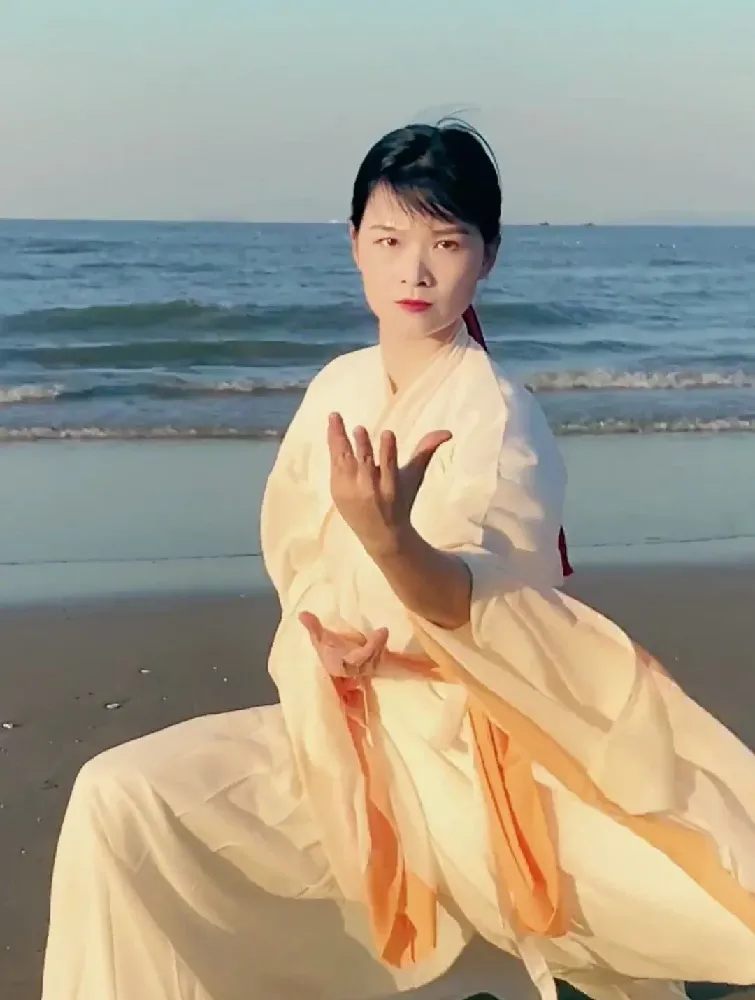
Conclusion: Relaxation Is a Skill, Not a Suggestion
“Sink the shoulders, drop the elbows” isn’t a quick fix. It’s a lifelong practice. A conversation between gravity and grace.
So if you’re still wondering why your shoulders feel tight—don’t worry. If your shoulders still feel tight, remember: you're not doing it wrong—you're doing it consciously. And that awareness is the first, and most important, step. We are all still learning.
True relaxation isn’t passive. It’s powerful. It’s the art of letting go—without falling apart.
Ready to Refine Your Form?
- For You: Want expert eyes on your posture? Join our Taichi Academy and get personalized feedback on how to sink and soften, with video analysis from our instructors.
- For Your Practice: Struggling to remember all this in practice? Download our FREE 'Sink & Drop' Quick-Reference Poster—a visual guide you can print and keep in your practice space.
Your softness is your strength. Let’s unlock it—together.
FAQ: Sink Shoulders, Drop Elbows — What It Really Means in Tai Chi
Sink Shoulders Drop Elbows — What does it actually mean?
It means allowing the shoulders to relax downward and the elbows to hang naturally below the wrists. It’s not a forced push or a rigid tuck—it’s a soft release supported by correct posture and gravity.
Tai Chi shoulder relaxation — Why is it so hard?
Because most of us carry tension in our shoulders unconsciously. Trying to “relax” often leads to pushing them down, which activates more tension. True shoulder relaxation comes from whole-body alignment and breath awareness.
Tai Chi elbow position — What’s the correct angle?
Your elbows should be lower than your wrists, forming a soft curve. Avoid locking or clamping them in. A good rule: keep a rounded shape under the armpits and maintain a gentle bend—never straight, never collapsed.
Correct Tai Chi posture — How does it affect shoulder tension?
Poor posture—like lifted collarbones or collapsed spine—forces the shoulders to compensate. When your spine is upright and your tailbone sinks, the shoulders naturally relax. Posture is the foundation of softness.
Why are my shoulders tense in Tai Chi even when I try to relax?
Because relaxation isn’t just a mental command—it’s a physical skill. You may be holding tension in your traps or trying too hard. Use imagery, breath, and structural cues to guide the release.
Peng energy and shoulder position — What’s the connection?
Peng energy is expansive and elastic. To feel it, your shoulders must sink and your elbows must drop. This creates the rounded, buoyant structure that supports internal force without stiffness.
Tai Chi for shoulder pain — Can this principle help?
Yes. Many shoulder issues stem from chronic tension and poor alignment. Learning to sink the shoulders and drop the elbows can reduce strain, improve joint mechanics, and ease discomfort over time.
